 TigerSoft News Service 10/6/2009
www.tigersoft.com
TigerSoft News Service 10/6/2009
www.tigersoft.com Other Free Tiger Blogs - http://www.tigersoft.com/Tiger-Blogs/index.htm
GOLD's HISTORIC BREAKOUT
MAKES US REMEMBER THE 1970's
by William Schmidt, Ph.D.
1976-1980: 550% Rise in 4 Years with Democrats in Power.

Buy and Holding Is Dangerous See All The Peerless Real-Time Signals: 1981-2009
Tiger Software - Helping Investors since 1981 Make Your Retirement Grow
Suggestions:
Peerless Stock Market Timing: 1928-1966
Track Record of Major Peerless Signals
Earlier Peerless-DJIA charts
7 Paths To Making 25+%/Yr. Using TigerSoft
Index Options
FOREX trading
Investing Longer-Term
Mutual Funds
Speculative Stocks
Swing Trading
Day Trading
Stock Options
Commodity Trading
Research on
Individual Stocks upon Request: Composite Seasonality Graph
of Any Stock for $125. Example of
historical research NEM - Newmont Mining. Order Here.

GOLD MADE AN ALL-TIME NEW HIGH TODAY.
It has taken years to develop this pattern.
It is very unlikely that this is a minor false breakout.
A sharp rise in gold usually leads to a steep stock market decline in a matter of weeks or a few months.
Gold traders can make some money now buying gold stocks. But, it is likely, that the US stock markets
are coming much closer to the start of a serious downturn. So far, the decline has been avoided. And so
far, our Peerless system has not given a Sell signal. But a sharp rise in Gold usually ends badly for the general
stock market. Consider the case of how well gold producer Newmont's rise in 1987 predicted
the Crash. The stock took off in July 1987. At the end of September, the stock showed serious
big money distribution. The rally to 54 was accompanied by negative readings from the TigerSoft
Accumulation Index. At the beginning of October 1987, Peerless gave a major Sell on the DJI. And
just three weeks later, the DJI was 35% lower and NEM had given back all its gain.
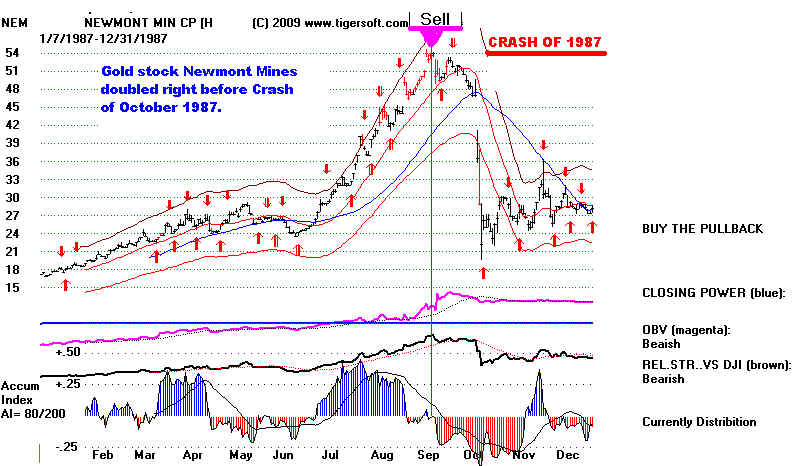
Between 1977 and 1980, when then Democrats were in power, gold rose more than 550%. It was
a rough period of time for investors. Each and every produced either a bear market or a mini-crash.
That was a time when Carter's appointment as Chairman of the Federal Reserve, Pail Volcker, raised
interest rates to 20% to combat commodity speculation and prevent a downward spiral of the Dollar.
Our current Fed Chairman, Ben Bernanke, has studied the 1930s closely and concluded that the
Federal Reserve then could have headed off the Depression by dramatically lowering interest rates.
"Easy money" is Bernanke's appraoch now. Under this policy, US Banks can borrow money from
the Fed at rates close to 0%. They can then buy US Treasuries and pocket the difference. Yesterday,
he reaffirmed this policy and said that interest rates will not go up any time soon. He undoubtedly realizes
that if he raised rates, the interest on the 2 trillion Dollars of US indebtedness would quickly bury
the US Treasury under even more massive debt.
Bernanke's announcement that low interest rates will continue for some time coupled with the
huge prospective budgets is very bullish for Gold. It vitrtually guarantees Gold speculators that
they need not fear a sudden rise by the FED of iinterest rates to defend the weakening Dollar. Raising
interest rates makes US Treasury securities more attractive to foreigners and is one of the major ways
a country can make its currency more attractive internationally as it finances its debt.
The period of time, the 1930s, that Bernanke studied did not have the Dollar playing the major role it does
now as an international currency. It is not clear that Bernanke sufficently realizes that his "cheap money"
approach, as appropriate as it might be if high unemployment and a slack economy were the only
considerations and US banks actually lent the money they borrow out to small businesses.
But the banks are mostly sitting on T-Bills or playing the stock market with the cheap money the
Fed is giving them. They are actually cutting back on loans, by all reports. Clearly banks are not helping
finance a recovery, unless it is assumed that rising stock prces will encourage stock traders to spend
more money. This is "trickle down" economics. It does not address the severe inequalities of wealth
and income in the US. It makes them worse. Most people have very little money, when 5% own
95% of all wealth. An economic recovery in this environment is very difficult or impossible. More and
more economists realize that such maldistrubtion of wealth lay at the heart of the Depression
(buying power was exhausted). It helps explain why FDR's New Deal ultimately failed to produce
an economic recovery. It took the economic collapse of Europe and Japan in World War II to
bring an American industrial recovery to millions and millions in the 1950s.
In Russia in 1906, Tsar Nicholas tried a variation on this "trickle down" approach with his "wager
on the strong" peasants. It failed and revolution followed.
"in 1906, a new Tsarist minister, Stolypin, launched an all-out attack on the peasant commune,
as the basis for the new policy known as the ‘wager on the strong'. Stolypin aimed to resolve both Russia's
economic problems and her social problems by fostering peasant differentiation and the destruction of
the ‘village community' ...(by encouraging) richer peasants to consolidate their landholdings and produce
bigger commercial surpluses, fostering agricultural growth, whilst poorer peasants would be driven off
the land and into the cities where they could be kept in check by repression more easily...Stolypin was
assassinated by an anarchist (middle class) peasant organiser (Narodnik) in 1911, and there is no doubt
that Stolypin's ‘reform' of traditional agrarian structure ...made an important contribution to fueling the
social revolutionary process which erupted five years later...(and led to the Soviet revolution.) "
( http://era.anthropology.ac.uk/Era_Resources/Era/Peasants/russia.html )
And, potentially making matters
much worse, foreigners are now vocally losing confidence in the US Dollar and
are starting to favor other
currencies, like the Euro or Yen. If foreigners, particularly the Chinese, decide
suddenly and en masse to dump their
Dollars and sell their US Treasury Securities, because the decline in the Dollar
is reducing these investments
intolerably, the Dollar may crash down sharply in value vis-a-vis other
currencies. In that event,
Americans will find that much of what they buy in stores suddenly will be much
higher priced, exactly at a time
when many are jobless and have so little money, as it is already. The
government printing presses at the
Treasury will be turned loose, as lenders disappear, and the Dollar
will go into a terrible spiral
down. Gold will be one of the few safe places for Americans to to keep their
savings safe.
US DOLLAR'S DOWNTREND
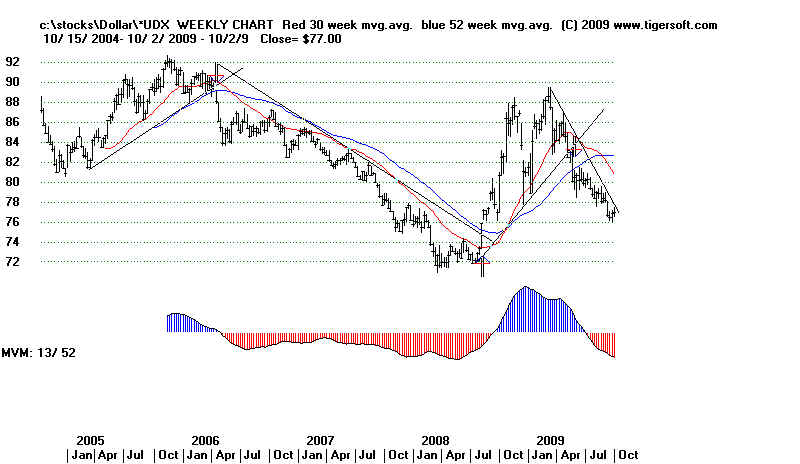
CLASSIC TECHNICAL ANALYSIS NOW
SETS UP
A MINIMUM TARGET OF 130 FOR GLD
AND A
MINIMUM TARGET OF 1300 FOR GOLD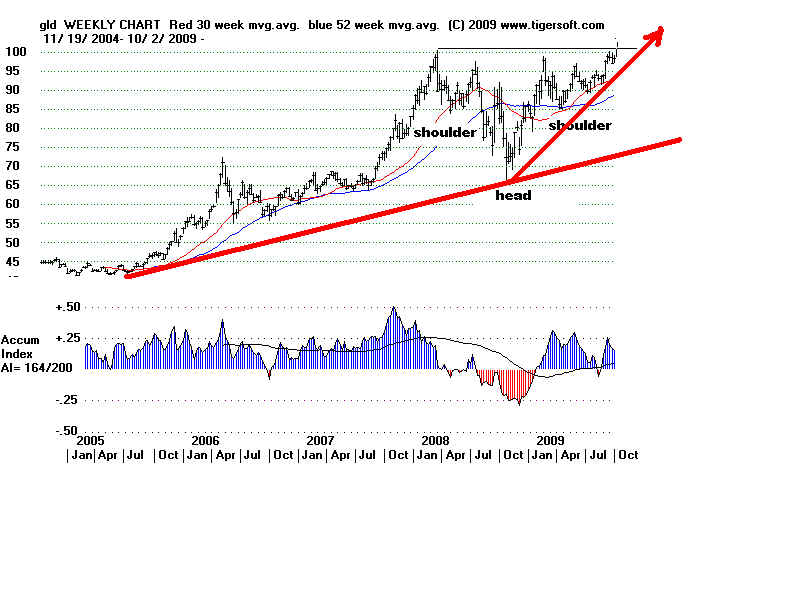
(1) GOLD IS THE BIGGEST
GAINER FOR THE LAST YEAR AMONG ALL INDUSTRY GROUPS,.
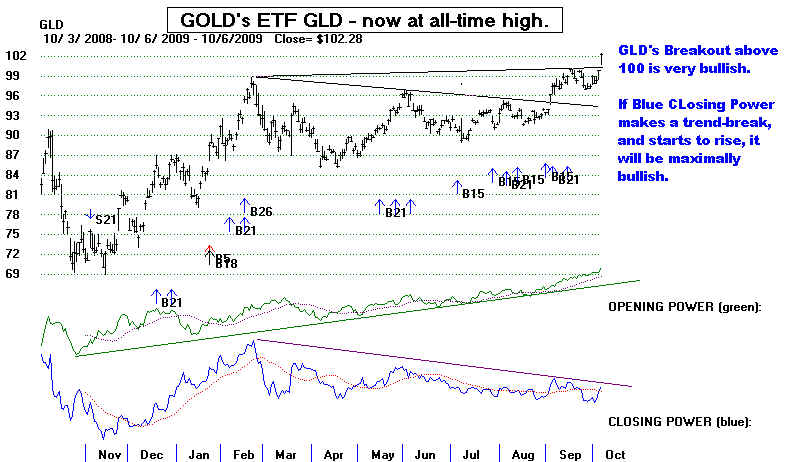
(2) GOLD AND STOCKS ARE
PARTICIPATING VERY WELL.
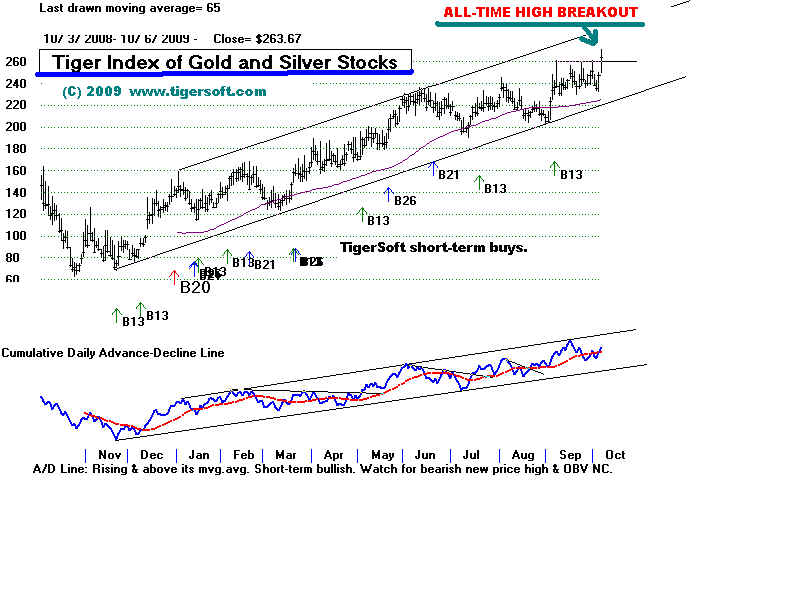
(3) MANY STOCK MARKET
AVERAGES DENOMINATED BY GOLD
ARE DECLINING
